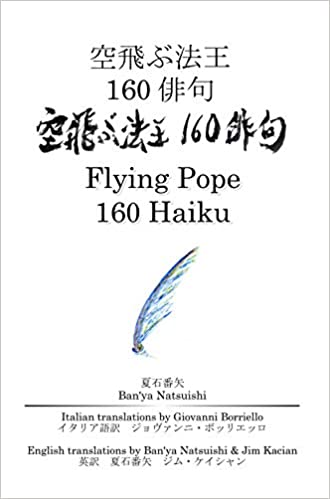
Reflections on Ban’ya Natsuishi’s Flying Pope 160 Haiku
Many years ago I went to view an exhibition titled “Hands”, a series of photos by Japanese artist Yasu Suzuka (鈴鹿芳康) a friend, and respected senpai. There were many large black and white close-up photos of hands in the prayer position, as well as many small color Polaroid photos of ordinary people, hands grasped in prayer arranged in various patterns. Reflecting on the show later I wrote in my journal: “only Suzuka-sensei, a Buddhist influenced conceptual artist, could pull this off, make it have meaning, and not be boring.”
Amazon USAReflections on Ban’ya Natsuishi’s Flying Pope 160 Haiku
Cyberwit.net, 2021, English, Japanese, Italian tri-lingual edition
By Edward Levinson (Edo) エドワード・レビンソン(恵道)
Many years ago I went to view an exhibition titled “Hands”, a series of photos by Japanese artist Yasu Suzuka (鈴鹿芳康) a friend, and respected senpai. There were many large black and white close-up photos of hands in the prayer position, as well as many small color Polaroid photos of ordinary people, hands grasped in prayer arranged in various patterns. Reflecting on the show later I wrote in my journal: “only Suzuka-sensei, a Buddhist influenced conceptual artist, could pull this off, make it have meaning, and not be boring.”
Reading Ban’ya Natsuishi’s Flying Pope 160 Haiku collection had the same affect on me. Fans and followers of Ban’ya will know that he is super-prolific in his haiku writing as if they are endlessly falling from a waterfall (to quote from the opening haiku). For most of us haiku writing mortals, it is more often a slow flowing stream or a deep well; we have to work hard to bring up a bucket or even small cups of water to create an enlightened haiku from our experiences and inspirations.
Falling from the waterfall
in the sky
the pope begins to fly
(P 19)
With Ban’ya’s inspired Flying Pope we find ourselves viewing personal life questions, politics, the environment, war and peace! We are faced with despair, humility, humor, and universal pathos. One does not need to be Christian or Catholic to get something out of these haiku with their linked theme of a Flying Pope, whoever or whatever he/she might be. Lets call it symbolism that is both personal and universal.
Darkness –
the Pope flies
faster than a bullet
(P 53)
Does this reflect the need of the world to act very quickly right now to save our selves and the planet from unimaginable ends?
Banya’s Flying Pope is NOT always “The Pope” in my interpretations even though there are references to the real Pope’s inner and outer journey. However, the image of a spiritual guide in flowing white robes is one that is easy to see and intrigues me. The important thing is that I see a spiritual being: one with power to lead and influence the world, involved with worldly situations, concerned with peace and joy. It can also be a lonely life.
Flying Pope
never encounters
flying Christ
(P 59)
And there are certainly sad times when no one pays any attention to this enlightened spiritual guide.
Here and there
windows close noisily
Flying Pope
(P60)
At the same time the Flying Pope is very human with everyday problems. He embodies a spiritual teaching coming out of Christianity: “to be in the world, but not of the world”. Its similar in my mind to the “middle way” found in Buddhism 中道. Sufi mystic and teacher Hazrat Inayat Khan (b. 1882 d. 1927) called it “Mastery Through Accomplishment”, meaning mastery over your inner self while remaining active in the everyday world.
For me this seems to be the goal for Banya’s Flying Pope. While flying he is saluted by a small desert mouse, he hears a singing voice from a village of mud, and says he is sorry to a thousand-years-old cedar. He battles for peace and good will and tries to be tolerant when things don’t work out as hoped for. (P 63, 97, 75)
Barely touching the torch
of the Statue of Liberty
the pope flies
(P 57)
Working so hard for liberty, both physical and spiritual, it reminds us our efforts can seem so small against the enormity of the task.
The Pope Flies out of
the meeting room
filled with beasts
(P 63)
Is it an unsuccessful political battle or a metaphor for us meeting our own demons?
Playing a cello
Flying Pope
weeping
(P 39)
The soulful sound of a cello is a thing of beauty, yet it is easy to see this spiritual being weeping, feeling the cry of humanity. Perhaps he also weeps for himself and his lost freedom upon finding himself enclosed in a cage (P 40) due to his high position.
However, amidst all the darkness the Flying Pope maintains his connection with the light; images of the sun and fire remind us of the goal of illumination.
Becoming
a sunspot
Flying Pope
(P 49)
Here we see the Pope in his meditative or prayer state, becoming one with the light; flying, we see him rise to greet and embrace it.
The wind blows
The Flying Pope
looks like a fire
(P 59)
The breath of the wind fans the fire, conjuring up images of enlightened mystics burning with love.
The Flying Pope keenly observes the world, while our place is to observe him as a model of inspiration and compassion, and imitate his example in our own way. He makes a difference by contributing to the world. Ban’ya Natsuishi encourages us to notice these things. Using disarmingly simple imagery and themes within the brevity of the haiku form, he allows us space to expand our minds and hearts and hopefully fly along with the Pope. Bon voyage!
Out of the corridor
of delusions
the Pope takes off for a flight
(P 69)
